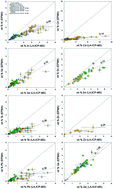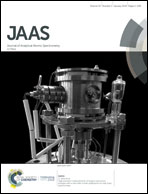LA-ICP-MS analyses of Fe-rich alloys: quantification of matrix effects for 193 nm excimer laser systems†
Abstract
Laser-ablation inductively coupled plasma mass spectrometry (LA-ICP-MS) is increasingly used to determine major, minor and trace element concentrations in Fe-rich alloys. In the absence of matrix-matched standards, standardization is often based on silicate glass reference materials. This approach could result in significant matrix effects. Here, we quantify these matrix effects for a wide suite of volatile to refractory trace elements during ns-excimer LA-ICP-MS analyses of Fe-rich alloys by comparing measured LA-ICP-MS concentrations with results from electron microprobe analysis (EPMA). Measurements performed with LA-ICP-MS consistently overestimate the concentration of volatile elements in metals relative to concentrations measured by EPMA. In contrast, the concentrations of non-volatile and refractory elements in Fe-rich alloys are systematically underestimated with LA-ICP-MS relative to EPMA. To quantitatively describe these offsets, we consider the fractionation index (Fi) for element i, or the ratio between the EPMA- and LA-ICP-MS determined elemental concentrations. The Fi is found to be independent of concentration and type of Fe-rich alloy considered, and ranges from >0.14 for the most volatile elements to ≤1.8 for the most refractory elements. The Fi correlate positively with the 50% condensation temperature of the elements considered, suggesting the matrix effects are predominantly the result of ablation-induced evaporative and/or melting processes at the ICP site. Comparison of the results with results from previous studies obtained for metals and sulfides using similar laser systems for a smaller subset of elements generally confirms the magnitude of the observed matrix effects for metals. These results were used to quantify the effects of matrix effects on calculated metal-silicate partition coefficients (D, defined as the metal to silicate abundance ratio by weight) derived from high-pressure experiments. The comparison was done by considering uncorrected and corrected LA-ICP-MS derived metal concentrations, where ‘‘corrected’’ concentrations were obtained by multiplying uncorrected LA-ICP-MS values with the appropiate Fi values derived here. Our results show that neglecting matrix effects will result in erroneous partitioning results for many volatile and refractory elements. The matrix effects described here should therefore be taken into account in future applications of ns-LA-ICP-MS for Fe-rich metal analysis if metal standards are not available for calibration.



 Please wait while we load your content...
Please wait while we load your content...